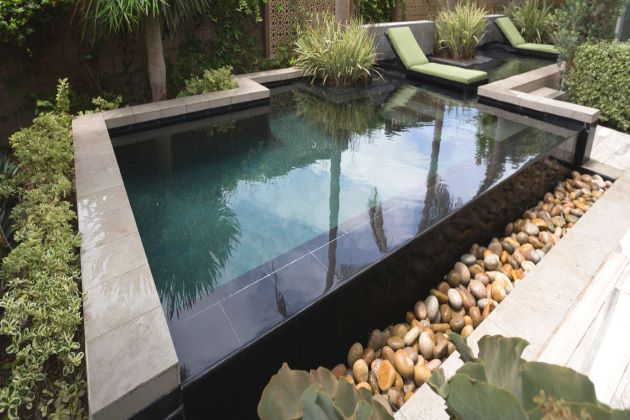Owning a pool requires some knowledge on general pool maintenance, including water balance and pool chemicals. By far, the most popular pool chemical is pool chlorine. Unfortunately, that’s not the only pool chemical you’ll need to keep you water balanced.
We have put together a list of specialty pool chemical definitions so you understand what each chemical does and how to use it.
Pool Algaecides
There are various types of pool algae, including: yellow/mustard, green, brown and black. Pool algaecides destroy algae, after there is already a bloom in your pool, spa or water feature. Algaestates work proactively to inhibit pool algae growth from ever starting.
Chelated Copper Compound
Chelated copper compound treats all types of pool algae. The copper blocks algae’s ability to consume food by disrupting enzymatic activity in its cells. The chelating agents helps prevent the risk of copper staining your pool surfaces.
Colloidal Silver
Colloidal Silver treats all types of pool algae. Similar to copper, colloidal silver starves the algae by disrupting its enzymatic processes.
Quaternary Ammonium
Quaternary Ammonium is an effective algaestat that treats green and blue-green algae in pools. This chemical is similar to polyquats (below), but works faster due to its smaller size. The electrical charge isn’t compounded as strong as polyquats, which can cause foaming if agitated.
Polyquat
Polyquats can affect all types of algae, but works best with green algae. The strong electrical charge will suffocate the growth of pool algae. This non-foaming chemical also acts as a water clarifier. It’s less effective on mustard and black algae.
Shop Pool Algaecides HERE.
Alternative Algae Chemicals
These algae fighters treat pool algae and other water problems, but may not have an EPA registration for the task.
Anhydrous Ammonia
Anhydrous Ammonia treats yellow (mustard) algae and large green algae blooms. This chemical acts as a chlorine booster to destroy pool algae from the inside out.
Borate Compound
Borate Compound treats all types of algae in pools. This compound interferes with algal photosynthesis by disrupting enzymatic activity.
Shop Alternative Algae Chemicals HERE.
Water Balancers
Water Balancers help control the chemical levels inside your pool water.
Calcium Chloride
Calcium Chloride is a powerful chemical when the calcium level is too low in your pool water. The flaked calcium salt chemical is used to raise levels of Calcium Hardness in your pool water.
Carbon Dioxide
Use Carbon Dioxide when the pH level is too high in your pool water. It lowers the pH level and increases the Total Alkalinity level, usually in the form of a CO2 chemical feeder.
Muriatic Acid
Muriatic Acid is the liquid dilution of Hydrochloric Acid, which is used to lower the pH level. Similar to Carbon Dioxide, Muriatic Acid will also increase the Total Alkalinity in your pool water. Use caution – this chemical is extremely caustic and corrosive.
Sodium Bisulfate
Use Sodium Bisulfate when the Total Alkalinity level is too high. Again, this chemical will lower the pH level, as well as the alkalinity in your water. This will also counteract scaling.
Sodium Bicarbonate
Use Sodium Bicarbonate (aka baking soda) when the Total Alkalinity level is too low. This specialty chemical will increase the alkalinity higher than the pH level.
Sodium Carbonate (Soda Ash)
Use when the pH level is too low. Sodium Carbonate is an easy way to increase the pH level in your pool water.
Shop Pool Water Balancers HERE.
Water Clarifiers
Water Clarifiers bind tiny particles together so they can be vacuumed or filtered out of the pool. This will in turn remove any water cloudiness.
Polymer
Polymer is made up of repeating polymer molecules, which is used to treat cloudy water. Polymer has a positive charge to coagulate small particles in the pool water.
Chitin
Chitin is a naturally occurring polymer found in shellfish. It is used to treat cloudy water. Chitin, also known as Shellfish Polymer, acts as a flocculant and chelating agent for oils, metals and organic materials in the pool water.
Shop Pool Water Clarifiers HERE.
Defoamers
Water Defoamers will react on water surface tension, reducing foam that was caused by organic contaminants.
Shop Spa Defoamer HERE.
Enzymes
Enzymes are used to break down and digest oil from the water surface. This helps accumulate the oily substances in the pool filter.
Shop Enzyme Pool Chemicals HERE.
Flocculants
Flocculants are used to coagulate tiny particles, making them large enough to vacuum out with a pool cleaner.
Aluminum Sulfate
This flocculant chemical helps treat hazy/cloudy pool water. Aluminum Sulfate binds small particles, making them sink to the bottom of the pool and easy to vacuum. A small amount of Aluminum Sulfate can also be used as an additive to pool sand filters.
Polyaluminum Chloride
This chemical is also used to treat cloudy water. Polyaluminum Chloride will coagulate tiny particles so they are large enough to get vacuumed out of the water.
Shop Pool Flocculant Clarifier HERE.
Metal & Stain Removers
These chemicals are used to neutralize the effect of metals in your pool water. They are used to lift metal stains from surfaces and to remove metal discoloration from the water. A Chelating Agent will fix the problem when it begins to appear. Sequestering Agents are used to prevent metal staining.
Chelating Agent
Chelating Agent is used to treat discolored water from metals in the pool water. The chelating agent is water soluble molecule that bonds tightly with metal ions to keep them from depositing stain and scale on pool surfaces. Chelating Agent forms a bond with metal ions, allowing them to be large enough to get filtered out of the pool.
Sequestering Agent
Sequestering Agent is used to prevent metal staining and metal-discolored water. Sequestering Agent holds the minerals in solution, preventing precipitation surface stains. These are typically referred to as stain and scale removers.
Shop Metal and Stain Removers HERE.
source: https://blog.poolsupplyworld.com/specialty-pool-chemical-glossary/




